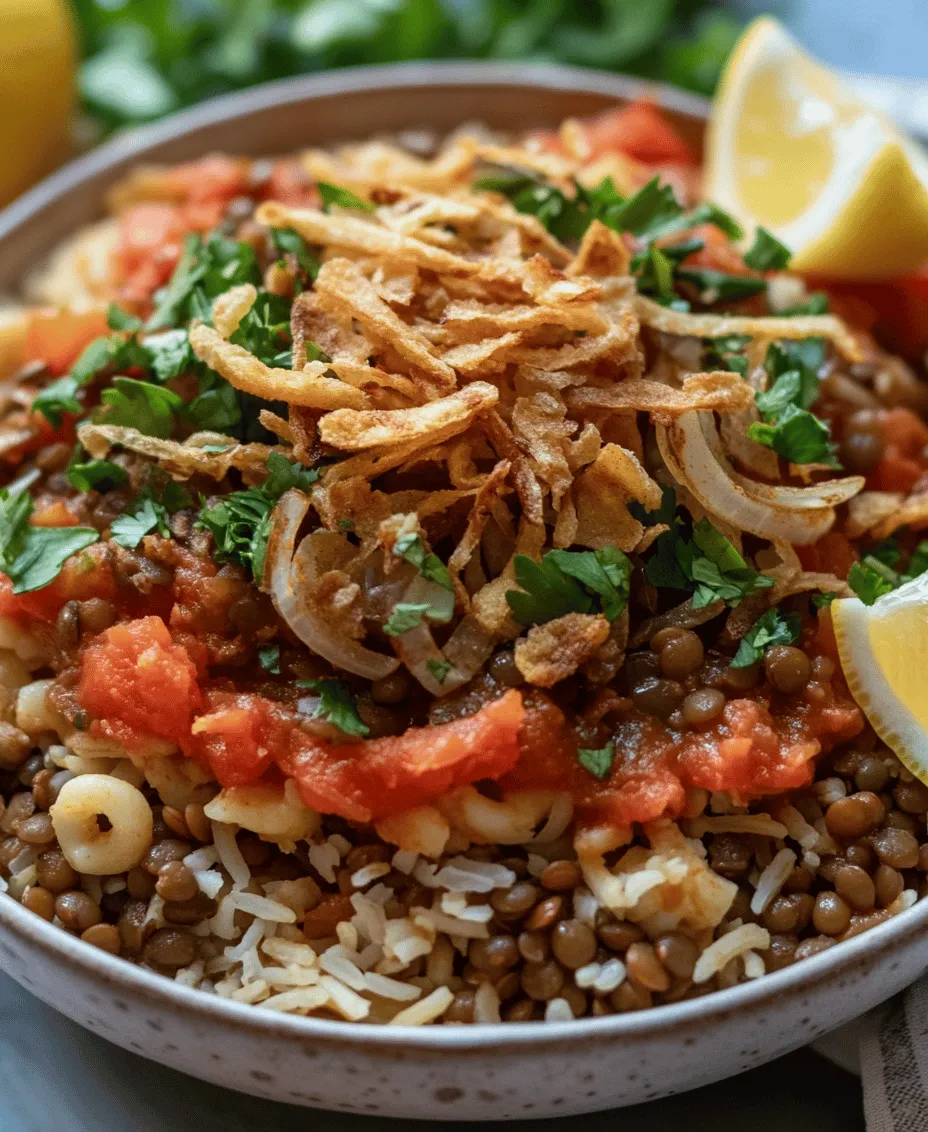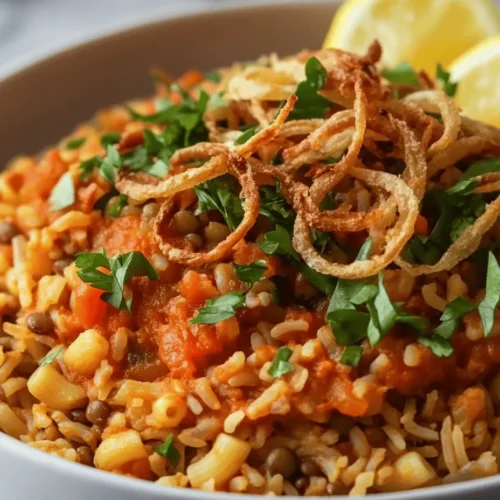Koshari is not just a dish; it’s a culinary experience that encapsulates the heart and soul of Egyptian cuisine. A delightful amalgamation of flavors and textures, Koshari is a satisfying blend of lentils, rice, macaroni, and a zesty tomato sauce, topped off with a hint of fried onions. This beloved street food is not only a staple in Egyptian households but also a symbol of community and celebration. As we explore Koshari, we will uncover its rich history, cultural significance, and provide a detailed, step-by-step guide to creating this emblematic dish right in your own kitchen.
The Cultural Significance of Koshari
Exploring the History of Koshari
Koshari’s roots can be traced back to the 19th century, reflecting Egypt’s rich cultural tapestry influenced by various culinary traditions. The dish is believed to have originated from the Indian dish “khichdi,” a mixture of rice and lentils that traveled to Egypt through trade routes and cultural exchanges. Over time, Egyptian chefs adapted the recipe, incorporating local ingredients and flavors, leading to the creation of Koshari as we know it today.
The dish gained popularity during the British occupation of Egypt, where it was commonly sold by street vendors. It quickly became a favorite among all classes, thanks to its affordability and nutritional value. Koshari embodies the idea of “food for the people,” making it a beloved staple that transcends socioeconomic boundaries.
Understanding its Roots in Egyptian Cuisine
Koshari is often referred to as the national dish of Egypt, and rightfully so. It showcases the typical Egyptian approach to cooking, which emphasizes the use of simple yet flavorful ingredients. The combination of legumes, grains, and pasta not only provides a hearty meal but also reflects the resourcefulness of Egyptian cooks who have historically used what was available to them.
In addition to its nutritional benefits, Koshari serves as a symbol of unity. It is commonly prepared for large gatherings, family celebrations, and community events, highlighting its role in bringing people together over a shared meal.
Koshari as a Street Food Staple in Egypt
One of the most endearing qualities of Koshari is its status as a beloved street food. In bustling markets and busy streets of Cairo, you’ll find numerous Koshari vendors serving up steaming portions of this hearty dish. Street vendors specialize in perfecting their own unique recipes, often featuring secret spice blends or signature sauces, making each bowl of Koshari a little different from the next.
The Koshari experience is not just about the food; it’s about the atmosphere. Eating Koshari at a street stall allows one to soak up the vibrant energy of Egyptian urban life, as families and friends gather around tables, sharing stories and laughter over their bowls of comfort food.
Koshari’s Role in Celebrations and Family Gatherings
In Egyptian culture, food plays a central role in celebrations and family gatherings, and Koshari is no exception. Whether it’s a festive holiday, a wedding, or a simple family get-together, Koshari often graces the table as a dish that brings everyone together. Its ability to feed a crowd without breaking the bank makes it an ideal choice for communal dining.
The dish is often accompanied by a variety of sides, such as crispy fried onions, spicy tomato sauce, and a tangy vinegar dressing that enhances the overall flavor profile. These accompaniments not only elevate the dish but also invite guests to customize their bowls to their liking, making each serving a personal creation.
Ingredients: What Makes Koshari Unique?
Koshari’s charm lies in its simplicity and the harmonious blend of its ingredients. Below, we’ll take a closer look at the key components that make Koshari a standout dish.
Overview of Key Ingredients
To prepare Koshari, you will need the following key ingredients:
– Brown Lentils: These provide a hearty, protein-rich base that is the backbone of the dish.
– Basmati Rice: Known for its fragrant aroma and fluffy texture, Basmati rice complements the lentils perfectly.
– Elbow Macaroni: This small pasta adds a delightful chewiness that enhances the dish’s overall texture.
– Tomato Sauce: A rich, zesty tomato sauce brings all the flavors together and adds moisture to the dish.
– Fried Onions: Crispy fried onions on top provide a crunchy contrast to the soft grains and lentils.
– Spices: A blend of spices such as cumin, coriander, and garlic powder elevates the flavor profile, giving Koshari its authentic taste.
Understanding the Role of Brown Lentils
Brown lentils are a staple in many dishes around the world, but they hold a special place in Koshari. They are packed with protein, fiber, and essential nutrients, making them a healthy addition to any meal. When cooked, brown lentils maintain their shape, providing a pleasant texture that complements the other components of Koshari.
The Importance of Basmati Rice
Basmati rice is renowned for its long grains and aromatic fragrance. It is essential in Koshari as it absorbs the flavors of the spices and sauces, creating a beautifully layered dish. The fluffy texture of Basmati rice contrasts nicely with the soft lentils and chewy macaroni, contributing to the overall mouthfeel of Koshari.
Why Elbow Macaroni is Essential
Elbow macaroni is a unique addition to Koshari, setting it apart from many other lentil and rice dishes. Its small size and curved shape allow it to mingle with the rice and lentils, ensuring that each bite is a delightful mix of flavors and textures. Cooking the macaroni to the right level of doneness is crucial, as it should remain firm enough to hold its shape without becoming mushy.
The Flavor Profile of Spices Used
The spices in Koshari are what truly make this dish sing. A blend of cumin, coriander, and garlic powder adds depth and warmth, enhancing the natural flavors of the lentils and rice. The spices should be carefully balanced to ensure that they elevate the dish without overpowering it. The addition of a pinch of chili powder or cayenne can also introduce a subtle heat, appealing to those who enjoy a little spice in their food.
The Role of Tomato Sauce in Koshari
The tomato sauce is the pièce de résistance of Koshari, tying all the elements together. Made from fresh tomatoes or canned tomato puree, the sauce is typically seasoned with garlic, cumin, and vinegar, giving it a tangy and savory flavor. The sauce not only adds moisture but also enriches the overall taste, making each bite of Koshari a flavorful experience.
Step-by-Step Preparation of Koshari Delight
Now that we’ve explored the cultural significance and key ingredients of Koshari, it’s time to roll up your sleeves and start cooking. Preparing Koshari might seem like a daunting task due to its multiple components, but with a little organization, you’ll be able to create this delicious dish with ease. Here are the initial steps involved in making Koshari.
Preparing the Brown Lentils
Rinsing and Cooking Lentils
Begin by measuring out 1 cup of brown lentils. Place them in a fine-mesh strainer and rinse them under cold running water to remove any dirt or impurities. After rinsing, transfer the lentils to a pot and cover them with about 3 cups of water. Bring the water to a boil over medium-high heat, then reduce the heat and let the lentils simmer for about 20-25 minutes, or until they are tender but not mushy.
Checking for Doneness
To check if the lentils are done, simply take a few out and taste them. They should be soft enough to eat but still hold their shape. Once cooked, drain any excess water and set the lentils aside while you prepare the rice and macaroni.
Cooking the Rice to Perfection
Rinsing and Cooking Techniques
Using 1 cup of Basmati rice, rinse it under cold water until the water runs clear to remove excess starch. This step is crucial for achieving fluffy, non-sticky rice. After rinsing, soak the rice in water for about 30 minutes to help it cook evenly.
To cook the rice, use a pot with a tight-fitting lid. Add the soaked rice to the pot along with 1.5 cups of water and a pinch of salt. Bring the water to a boil, then reduce the heat to low and cover the pot. Allow the rice to simmer for about 15 minutes, or until all the water is absorbed. Remove from heat and let it sit, covered, for an additional 5 minutes to allow the rice to steam.
Fluffing the Rice for Texture
After the resting period, use a fork to fluff the rice gently. This will separate the grains, ensuring that each bite is light and airy. Set the rice aside as you move on to the next component of Koshari.
Making the Elbow Macaroni
Best Practices for Cooking Pasta
For the macaroni, start by bringing a pot of salted water to a boil. Add 1 cup of elbow macaroni and cook according to the package instructions, usually around 7-9 minutes, until al dente. Make sure to stir occasionally to prevent the pasta from sticking together.
Ensuring the Right Texture
Once cooked, drain the macaroni and rinse it briefly under cold water to stop the cooking process. This helps maintain the desired texture. Set the macaroni aside while you prepare the flavorful tomato sauce.
Creating the Flavorful Tomato Sauce
The final step in the initial preparation of Koshari is to make the tomato sauce, which will bring everything together. In a saucepan, heat some olive oil over medium heat and sauté minced garlic until fragrant. Add crushed tomatoes, a splash of vinegar, and seasonings like cumin and chili powder. Simmer the sauce for about 15-20 minutes until it thickens and flavors meld beautifully.
With all components prepared, you are now ready to assemble Koshari and enjoy this remarkable dish that showcases the rich culinary heritage of Egypt.
Stay tuned for the next part, where we will guide you through the final steps of assembling Koshari Delight, including serving suggestions and tips for garnishing this iconic dish.

Sautéing Onions to Achieve Caramelization
To start your Koshari delight, the first step is to sauté the onions. This process is crucial for developing the dish’s signature flavor. Begin by slicing the onions thinly, aiming for uniform pieces to ensure even cooking. Heat a generous amount of vegetable oil in a large skillet or pot over medium heat. Once the oil is shimmering, add the sliced onions.
Sauté the onions slowly, stirring frequently. The goal is to achieve a deep golden-brown color, which typically takes around 15 to 20 minutes. This slow cooking allows the natural sugars in the onions to caramelize, imparting a rich sweetness that balances the savory elements of the dish. Be patient; if the heat is too high, the onions will burn rather than caramelize. Once they reach a beautiful caramel color, remove them from the heat and set aside. This step not only adds depth to your Koshari but also creates a lovely aroma that will entice anyone nearby.
Layering Flavors with Garlic and Spices
With your onions perfectly caramelized, it’s time to build on that foundation of flavor. In the same skillet, add minced garlic to the remaining oil. Sauté the garlic for about a minute until it becomes fragrant—be careful not to let it brown, as burnt garlic can taste bitter.
Next, it’s time to introduce the spices that will elevate your Koshari. Common spices include cumin, coriander, and a pinch of cayenne pepper for warmth. Stir the spices into the garlic, allowing them to toast for another minute. This step is essential as it releases the aromatic oils and intensifies the flavor of the spices. The combination of garlic and spices will create an irresistible base for your tomato sauce.
Simmering for the Perfect Sauce Consistency
To create the sauce for your Koshari, add crushed tomatoes (either canned or freshly blended) to the sautéed garlic and spices. Stir well to combine, and season with salt and pepper to taste. Allow the mixture to come to a gentle simmer. Reduce the heat and let it cook for about 15 to 20 minutes, stirring occasionally. This simmering process thickens the sauce, concentrates the flavors, and melds the ingredients beautifully.
You can adjust the consistency of the sauce by adding a splash of water or vegetable broth if it becomes too thick. Taste the sauce periodically and adjust the seasoning as necessary, balancing the tang of the tomatoes with the warmth of the spices. Once the sauce has reached a rich, thick consistency, remove it from the heat, and set it aside while you prepare the rest of your Koshari components.
Combining the Ingredients: Building Your Koshari
Layering the Lentils, Rice, and Macaroni
Now that you have your flavorful sauce, it’s time to assemble your Koshari. Begin with the base: the cooked lentils, rice, and macaroni. The order of layering is crucial for achieving the perfect texture and flavor balance. Start by placing a generous mound of rice at the bottom of your serving dish. The rice will absorb the flavors from the sauce and provide a hearty foundation.
Next, add a layer of cooked lentils. Lentils not only add protein but also contribute a nutty flavor that complements the rice beautifully. Follow this with a layer of cooked macaroni. The macaroni adds a delightful texture and an extra element of comfort to the dish.
The Importance of Order in Layering
The order in which you layer these components is important, as each layer will absorb flavors from the others. By starting with rice, followed by lentils, and finally macaroni, you ensure that every bite of Koshari is a harmonious blend of flavors and textures. After layering, gently press down on each layer to compact them slightly, helping them hold together when served.
Adding Chickpeas for Texture and Protein
Once your base layers are complete, sprinkle a generous handful of cooked chickpeas over the top. Chickpeas add an additional layer of texture and protein, making Koshari a wholesome meal. Their slightly nutty flavor complements the other ingredients beautifully.
Pouring the Tomato Sauce
After layering the base ingredients, it’s time to add the tomato sauce. Pour the sauce evenly over the entire dish, ensuring that every layer is well-coated. This not only enhances flavor but also adds moisture, making the Koshari delightful and not dry. Use a spatula to gently spread the sauce if necessary.
Ensuring Even Distribution for Maximum Flavor
To achieve maximum flavor, ensure the sauce is evenly distributed across all the layers. This step is critical for ensuring that every bite of Koshari is bursting with the rich, tangy flavor of the tomato sauce. After pouring the sauce, you can top the dish with the reserved caramelized onions, which will add an extra crunch and sweetness.
Garnishing and Serving Your Koshari Delight
Once your Koshari is assembled, it’s time to think about garnishing and serving. Garnishing not only enhances the visual appeal of the dish but also adds additional flavors and textures.
Options for Garnishing Koshari
One of the most popular garnishes for Koshari is fried onions. You can prepare these by slicing onions thinly and frying them until golden brown and crispy. Scatter them generously over the top of your Koshari for a delicious crunch.
Another great option is fresh parsley. A handful of chopped parsley adds a pop of color and freshness to the dish, balancing the richness of the sauce and fried onions.
The Role of Fried Onions and Fresh Parsley
The combination of the crispy fried onions and fresh parsley not only enhances the visual appeal of your Koshari but also elevates the taste profile. The sweetness of the caramelized onions, the richness of the tomato sauce, and the freshness of the parsley create a delightful contrast that makes every bite enjoyable.
Serving Suggestions with Lemon Wedges
Serve your Koshari with lemon wedges on the side. A squeeze of fresh lemon juice over the dish just before eating brightens the flavors and adds a zesty kick that perfectly complements the hearty components of the Koshari.
Nutritional Benefits of Koshari
Analyzing the Nutritional Profile
Koshari is not just a delicious dish; it’s also packed with nutritional benefits. The combination of lentils, rice, macaroni, and chickpeas creates a well-rounded meal that provides a balance of carbohydrates, proteins, and vitamins.
The Health Benefits of Lentils and Chickpeas
Lentils and chickpeas are both excellent sources of plant-based protein, making Koshari a great option for vegetarians and vegans. They are also high in fiber, which aids digestion and helps maintain a healthy weight. Additionally, lentils are rich in iron, folate, and other essential nutrients, while chickpeas provide a good dose of vitamins and minerals, including manganese, phosphorus, and B vitamins.
Balancing Carbs, Proteins, and Vitamins
The rice and macaroni in Koshari provide carbohydrates for energy, while the lentils and chickpeas contribute protein and fiber, making the dish not only filling but also nutritious. With the addition of fresh parsley and tomatoes, Koshari also delivers a variety of vitamins and antioxidants that are beneficial for overall health.
Koshari in Today’s Culinary Scene
Modern Twists on Traditional Koshari
While Koshari is a traditional Egyptian dish, it has seen modern adaptations that cater to diverse dietary preferences. Chefs and home cooks alike have started to experiment with various ingredients and cooking methods, resulting in exciting twists on this classic dish.
Vegetarian and Vegan Adaptations
Many variations focus on enhancing the vegetarian or vegan aspects of Koshari. For instance, some cooks incorporate roasted vegetables or different types of grains, such as quinoa or farro, to add unique flavors and textures. Others might replace the tomato sauce with a creamy tahini sauce for a different flavor profile while maintaining the dish’s core essence.
Koshari Variations Across Different Regions
Koshari is enjoyed not only in Egypt but also in other parts of the Middle East, each region adding its unique spin. Some variations might include different spices or additional ingredients like fried eggs or spicy sauces. Exploring these regional variations can be a fun way to appreciate the dish’s versatility and cultural significance.
Conclusion: The Joy of Making Koshari at Home
Creating Koshari at home is more than just cooking; it’s a culinary experience that connects you to Egyptian culture and traditions. The process of layering flavors and ingredients is both satisfying and rewarding, culminating in a dish that is as delicious as it is nourishing.
Reflecting on the Culinary Experience
As you enjoy your homemade Koshari, take a moment to appreciate the rich history behind this dish and the joy it brings to the table. Cooking Koshari is an opportunity to explore flavors, experiment with ingredients, and share a beloved meal with family and friends.
The Importance of Sharing Koshari with Loved Ones
Food has a unique way of bringing people together, and Koshari is often served during gatherings and celebrations. Sharing this dish with loved ones creates lasting memories and fosters a sense of community.
Embracing the Cultural Heritage Through Cooking
By making Koshari at home, you not only indulge in a delicious meal but also embrace the cultural heritage of Egypt. It’s a celebration of flavors, traditions, and the love for food that transcends borders. So gather your ingredients, follow the steps, and enjoy the delightful journey of making Koshari, a true taste of Egypt.



